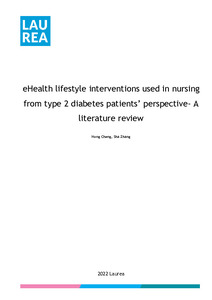eHealth lifestyle interventions used in nursing from type 2 diabetes patients’ perspective- A literature review
Cheng, Hong; Zhang, Sha (2022)
Cheng, Hong
Zhang, Sha
2022
All rights reserved. This publication is copyrighted. You may download, display and print it for Your own personal use. Commercial use is prohibited.
Julkaisun pysyvä osoite on
https://urn.fi/URN:NBN:fi:amk-2022121630391
https://urn.fi/URN:NBN:fi:amk-2022121630391
Tiivistelmä
Type 2 diabetes mellitus (T2DM) is a chronic metabolic disorder with insulin resistance and high blood glucose level. T2DM can lead to fatal health complications, such as cardiovascular disease, blindness, kidney failure and lower-limb amputation. Except the genetic factors, T2DM is highly affected by one’s lifestyle such as diet and physical activities.
The global prevalence of diabetes, shortage of nursing workforce, and the ubiquitous internet usage, many studies have evidenced that eHealth has the potential to promote healthy lifestyle to manage chronic diseases, to improve communication through the efficient delivery, to optimize healthcare related processes, reach more people and cost effectiveness.
The purpose of this paper is to explore eHealth lifestyle interventions used in nursing from T2DM patients’ perspective. The aim of this study is to study and describe eHealth lifestyle interventions used in nursing from T2DM patients’ perspective. Hence, the research question is what kind information do T2DM patients need regarding eHealth lifestyle interventions used in nursing?
A literature review was carried out in the study. Data was retrieved from reliable database via EBSCOhost (CINAHL) from January 2015 to September 2022. Ten relevant peer reviewed published articles were selected as the primary data for the thematic analysis.
The findings are that regarding eHealth lifestyle intervention used in nursing, T2DM patients highly desire patient-centered care and social support; in addition to abundant clinical nursing skills, the nurses’ knowledge concerning motivational interviewing and health-coaching skills is highly required by T2DM patients; the measurement tools that patients use during eHealth lifestyle intervention is blood glucose level, blood pressure level, body mass index and waist circumstance; eHealth intervention can be considered as an instrumental supportive tool for health lifestyle intervention for T2DM patients along with the traditional face-to-face health interventions.
The global prevalence of diabetes, shortage of nursing workforce, and the ubiquitous internet usage, many studies have evidenced that eHealth has the potential to promote healthy lifestyle to manage chronic diseases, to improve communication through the efficient delivery, to optimize healthcare related processes, reach more people and cost effectiveness.
The purpose of this paper is to explore eHealth lifestyle interventions used in nursing from T2DM patients’ perspective. The aim of this study is to study and describe eHealth lifestyle interventions used in nursing from T2DM patients’ perspective. Hence, the research question is what kind information do T2DM patients need regarding eHealth lifestyle interventions used in nursing?
A literature review was carried out in the study. Data was retrieved from reliable database via EBSCOhost (CINAHL) from January 2015 to September 2022. Ten relevant peer reviewed published articles were selected as the primary data for the thematic analysis.
The findings are that regarding eHealth lifestyle intervention used in nursing, T2DM patients highly desire patient-centered care and social support; in addition to abundant clinical nursing skills, the nurses’ knowledge concerning motivational interviewing and health-coaching skills is highly required by T2DM patients; the measurement tools that patients use during eHealth lifestyle intervention is blood glucose level, blood pressure level, body mass index and waist circumstance; eHealth intervention can be considered as an instrumental supportive tool for health lifestyle intervention for T2DM patients along with the traditional face-to-face health interventions.
